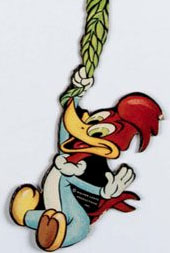 The 50’s were upon us, and the craze of monster movies and science fiction was giving blossom to an undergrowth of B-pictures. This shifted emphasis upon the startling seems to have run over into the animation industry, who, previously content with cavorting flowers of innocent intent, introduces, amidst a dew traditional stragglers, a new denizen beast to terrorize its bevy of animated stars – the man-eating plant!
The 50’s were upon us, and the craze of monster movies and science fiction was giving blossom to an undergrowth of B-pictures. This shifted emphasis upon the startling seems to have run over into the animation industry, who, previously content with cavorting flowers of innocent intent, introduces, amidst a dew traditional stragglers, a new denizen beast to terrorize its bevy of animated stars – the man-eating plant!
Alley To Bali (Lantz/Universal, 3/15/54 – Don Patterson, dir.), places Woody and Buzz Buzzard in one of their most exotic locales. The title is a play on that of the last of Paramount’s “Road” pictures with Bing Crosby and Bob Hope, Road To Bali, even though that series had already wrapped up with this final entry in 1952. In typical Bing and Bob tradition, Woody and Buzz, sailors on leave, encounter the seductive “Babalu” (reference to Desi Arnaz’s signature song, frequently referenced in I Love Lucy), a temple guardian who offers daily sacrifices to the local volcano god – except she’s down to offering onions and radishes, which only make the angry god burp. Insisting on human sacrifices, the fire god bids her to provide same on threat of destroying her people. Babalu plays the “Dorothy Lamour” parallel in luring Woody and Buzz up the mountainside with her exotic dancing. En route, two flower references appear. Woody slows rival Buzz up by handing him a long stemmed flower to give her as a gift. As Buzz smells the flower, we see that its stem is a skyrocket with glued-on petals. Woody lights the rocket and launches Buzz skyward, falling to Earth right in the center of one of animation’s first :man-eating plants (a topic which would become a favorite of later television cartoons, discussed below). The huge plant starts wrapping one leaf after another around Buzz’s limbs, then rolls one leaf into a fist to deal Buzz a knock-out punch. The leaves envelop Buzz, and transform into the image of a chewing face. But suddenly, Buzz’s taste is noticed. The plant’s “face” changes expression entirely, spits Buzz out with disgust – then the entire plant turns dead brown and withers entirely, accompanied by a descending-note honk on a trombone. This becomes the running gag of the film – as everything that encounters Buzz similarly turns brown and withers! Our heroes eventually escape the volcano – but remain weak in their resolve to swear off women, ending the film by mistaking a multi-armed octopus for another Balinese dancer.
Arts and Flowers (Lantz/Universal, Woody Woodpecker, 11/19/56 – Paul J. Smith, dir.) Returns to more traditional fare, and is a loose and non-stop assemblage of sight gags based on the plot vehicle of an art contest offering a big prize for the best picture of a desert flower. A nearby beret-wearing French artist (who makes his normal living painting pretty girls on men’s neckties) thinks the prize is “right up my alley”. But Woody has seen the contest advertisement too, and emerges from his treehouse with beret, painter’s smock, easel and brushes. The two try to sabotage each other’s departure for the desert, but end up in a dead tie as both their autos simultaneously lead them to “a desert daffodilly”. Various efforts at one-upsmanship abound. Each tries to position their easel in front of the view of the other – until Woody out-positions the Frenchman so that his next shift forward walks him off a cliff. Woody tries painting the quick way – dancing atop five tubes of paint which squirt colors at the canvas for a rickety image of the bloom – but the Frenchman brings down Woody’s masterpiece on his head. Woody replaces the Frenchman’s paint bucket with a bucket of paint remover – causing his entire image of the flower to vanish from the canvas. Then things start to get surreal. Woody paints a picture of a cactus, and places it on the Fenchman’s seat. The Frenchman of course gets a pants-full of cactus needles. Woody paints a bulldog on canvas, and a bone on the seat of the Frenchman’s trousers. The bulldog comes off the canvas to bite what it desires. Finally, Woody paints a train track under the Frenchman – which is followed by a real train. The Frenchman, his flower painting, and some twisted rails are flattened into the canvas – and Woody enters the mess into the contest and is acclaimed a “genius”. But first prize turns out not to be a sack of money – but a painting of a sack of money! A disgusted Woody smashes the painting over the judges’s head, doodles a moustache, beard, and squiggly hairdo on him, then exits the museum bouncing off the walls with the traditional Woody laugh.
 No writers appear on credits for some of the Popeye episodes created by TV Spots for the 1960’s series. However, one has to wonder if Homer Brightman, who was first writer on the script of the Woody, “sold out” his longstanding boss Lantz for a few quick bucks on this Jack Kinney cartoon – as virtually the entire script of Arts and Flowers appears again in Popeye form as Take It Easel during the King Features television run. While a number of new gags are added, many give away the cartoon’s roots – including the repositioning easels gag, a desert mirage gag with a painted pool, and the surreal train ending. This time, of course, Popeye is tied to the tracks, and saves himself by painting a can of spinach in mid-air, then bending the tracks to loop back at Bluto (Brutus).
No writers appear on credits for some of the Popeye episodes created by TV Spots for the 1960’s series. However, one has to wonder if Homer Brightman, who was first writer on the script of the Woody, “sold out” his longstanding boss Lantz for a few quick bucks on this Jack Kinney cartoon – as virtually the entire script of Arts and Flowers appears again in Popeye form as Take It Easel during the King Features television run. While a number of new gags are added, many give away the cartoon’s roots – including the repositioning easels gag, a desert mirage gag with a painted pool, and the surreal train ending. This time, of course, Popeye is tied to the tracks, and saves himself by painting a can of spinach in mid-air, then bending the tracks to loop back at Bluto (Brutus).
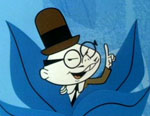 As theatrical cartoons waned, television returned to the precedent of terror by vegetation. In The Flower Plot (UPA, Dick Tracy, 1961 – Brad Case/Abe Levitow, dir.), Sketch Paree and the Mole set out to swipe the Yokohama lily – favorite to win the annual flower show – not realizing the bloom is sorely misnamed, and is really a man-eating flyrtrap. Asiatic stereotype Joe Jitsu (Benny Rubin) is assigned to guard the flower. The savage flora takes several nips out of the Mole’s pants, while Paree stays out of the line of fire as idea man to thwart the plant’s aggressive ways. Jitsu arrives just as Paree is about to administer a pail full of alum-laced water to pucker the plant’s lips so it can’t bite. Instead, he throws the pail on Jitsu, who is momentarily frozen and speechless. Then, he throws Jitsu to the plant. But the plant gently spits Joe out, and they exchange bows and Japanese greetings. Paree and Mole attempt and exit, but Jitsu judo flips them into the plant’s clutches. When Tracy arrives, both crooks are firmly held in the lily’s jaws by the seats of their pants. “How did you manage to get that man-eating plant on the side of the law?”, Tracy asks. Joe says he discovered that he and the plant both came from the same home town – Sacramento!
As theatrical cartoons waned, television returned to the precedent of terror by vegetation. In The Flower Plot (UPA, Dick Tracy, 1961 – Brad Case/Abe Levitow, dir.), Sketch Paree and the Mole set out to swipe the Yokohama lily – favorite to win the annual flower show – not realizing the bloom is sorely misnamed, and is really a man-eating flyrtrap. Asiatic stereotype Joe Jitsu (Benny Rubin) is assigned to guard the flower. The savage flora takes several nips out of the Mole’s pants, while Paree stays out of the line of fire as idea man to thwart the plant’s aggressive ways. Jitsu arrives just as Paree is about to administer a pail full of alum-laced water to pucker the plant’s lips so it can’t bite. Instead, he throws the pail on Jitsu, who is momentarily frozen and speechless. Then, he throws Jitsu to the plant. But the plant gently spits Joe out, and they exchange bows and Japanese greetings. Paree and Mole attempt and exit, but Jitsu judo flips them into the plant’s clutches. When Tracy arrives, both crooks are firmly held in the lily’s jaws by the seats of their pants. “How did you manage to get that man-eating plant on the side of the law?”, Tracy asks. Joe says he discovered that he and the plant both came from the same home town – Sacramento!
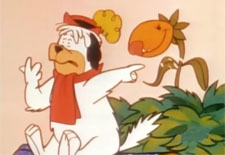 Dilly of a Lily (Hanna-Barbera, Touche Turtle, 1962) really doesn’t pack a whole lot of plot. A “cannibal plant”, again of the giant flytrap variety, this time capable of walking on its roots protruding from the bottom of its flower pot, breaks its chain and escapes from an experimental greenhouse. Its ability to speak is limited to one phrase: “Chomp, chomp.” The distress call goes out to Touche Turtle’s “shellphone”. Of course, Dum Dum is the one who finds the plant – or is it the other way around – as the plant chomps on Dum Dum’s arm, then tries to drag him away. In a strange moment, unique to the series, a Touche charge is mis-aimed, and Touche hits a tree, falling on his back. Dum Dum forces the plant to let go of his arm so that Dum Dum can help his boss by flipping him back to standing position. Touche thanks Dum Dum for saving him, describing it as his “one weakness”. The plant, however, has disappeared again. Touche grabs a painting set, and paints a picture of a T-bone steak on a large boulder. As he predicts, the hungry plant runs headfirst for the fake steak – and knocks himself cold. Returning the plant to the scientist’s greenhouse, Touche tells the scientist to just keep feeding the plant steaks, and he’ll stay happy. The scientist complains that with the price of steaks, it’d have been better if the plant stayed lost. Touche concludes that “They’re never satisfied.”
Dilly of a Lily (Hanna-Barbera, Touche Turtle, 1962) really doesn’t pack a whole lot of plot. A “cannibal plant”, again of the giant flytrap variety, this time capable of walking on its roots protruding from the bottom of its flower pot, breaks its chain and escapes from an experimental greenhouse. Its ability to speak is limited to one phrase: “Chomp, chomp.” The distress call goes out to Touche Turtle’s “shellphone”. Of course, Dum Dum is the one who finds the plant – or is it the other way around – as the plant chomps on Dum Dum’s arm, then tries to drag him away. In a strange moment, unique to the series, a Touche charge is mis-aimed, and Touche hits a tree, falling on his back. Dum Dum forces the plant to let go of his arm so that Dum Dum can help his boss by flipping him back to standing position. Touche thanks Dum Dum for saving him, describing it as his “one weakness”. The plant, however, has disappeared again. Touche grabs a painting set, and paints a picture of a T-bone steak on a large boulder. As he predicts, the hungry plant runs headfirst for the fake steak – and knocks himself cold. Returning the plant to the scientist’s greenhouse, Touche tells the scientist to just keep feeding the plant steaks, and he’ll stay happy. The scientist complains that with the price of steaks, it’d have been better if the plant stayed lost. Touche concludes that “They’re never satisfied.”
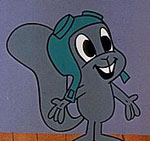 Pottsylvania Creeper (Jay Ward, 1963-64), from the final season of The Bullwinkle Show. Center of attention in Frostbite Falls is the local newspaper story about the annual Flower Show (the citizens never read the front page news, as the paper has printed the same front page for decades, as the stories are always the same). Bullwinkle has been so busy being a television hero, he’s failed to tend his garden, so has nothing to enter, until he meets farmer Pete Mc Moss (Boris Badenov) and his assistant I. V. C. Halls (the C stands for “Covered”), alias Natasha. For two bits, they sell him a bean said to be descended from Jack’s original beanstalk. At the flower show (a chaotic event in that the auditorium has booked a basketball game at the same time), Bullwinkle plants the seed – which produces a hungry looking flytrap. Bullwinkle truly has a green thumb – spearmint flavored, too. It wins first prize – but the judge disappears from the scene just after awarding it. Outside, as the plant grows too big to carry, another disappearance occurs, as a policeman accusing them of blocking traffic never finishes writing the ticket. And the plant is smiling. J. Edgar Bloomer from the F. P. I. (Federal Plant Inspector) arrives and recognizes the bloom as the only known specimen in the country of the Pottsylvania Creeper – a man-eating plant – then just as suddenly disappears like the others. The plant demonstrates its creeping ability by entwining itself clear around Rocky’s house.
Pottsylvania Creeper (Jay Ward, 1963-64), from the final season of The Bullwinkle Show. Center of attention in Frostbite Falls is the local newspaper story about the annual Flower Show (the citizens never read the front page news, as the paper has printed the same front page for decades, as the stories are always the same). Bullwinkle has been so busy being a television hero, he’s failed to tend his garden, so has nothing to enter, until he meets farmer Pete Mc Moss (Boris Badenov) and his assistant I. V. C. Halls (the C stands for “Covered”), alias Natasha. For two bits, they sell him a bean said to be descended from Jack’s original beanstalk. At the flower show (a chaotic event in that the auditorium has booked a basketball game at the same time), Bullwinkle plants the seed – which produces a hungry looking flytrap. Bullwinkle truly has a green thumb – spearmint flavored, too. It wins first prize – but the judge disappears from the scene just after awarding it. Outside, as the plant grows too big to carry, another disappearance occurs, as a policeman accusing them of blocking traffic never finishes writing the ticket. And the plant is smiling. J. Edgar Bloomer from the F. P. I. (Federal Plant Inspector) arrives and recognizes the bloom as the only known specimen in the country of the Pottsylvania Creeper – a man-eating plant – then just as suddenly disappears like the others. The plant demonstrates its creeping ability by entwining itself clear around Rocky’s house.
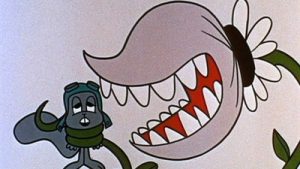 It grows so fast Rocky can’t lay axe blows on its vines twice in the same place. Rocky himself is almost captured, but Bullwinkle distracts the plant with a blowtorch hotfoot on its roots. However, the plant can’t be fooled twice, and sprouts a base of protective thorns. The plant terrorizes the town, growing into every building, with numerous additional citizen disappearances. Washington reacts (although the Secretary of Defense tries to dodge responsibility, claiming “It’s not a defense plant!”), but guns, flame throwers, tanks and bombs all prove useless. Fearless Leader arrives to survey his minions’ handiwork, enjoying with relish the final stage, as the plant’s vines coil into the shape of a missile and launch themselves skyward. The missile explodes, ejecting thousands of tiny seeds on parachutes. Rocky is unable to scoop them all up in time, and nearly takes a pot-shot from Fearless Leader. Confident that now the whole country shall be devastated, Fearless Leader takes Boris and Natasha back to Pottsylvania on the 9:22 submarine (“It always gets you back to Pottsylvania in time for the executions”). As the country is about to be abandoned, Rocky gets an idea from Bullwinkle’s comment, “The only thing we haven’t done is kiss it goodnight and tuck it into bed.” Rocky decides to see how the plant will react to kindness. While it can stand all forms of adversity, kindness gives the Creeper nervous breakdowns, causing it to wither away. All that remains is a single creeper seed – which is sucked into the air ventilation shaft of Fearless Leader’s submarine floating on the ocean surface. At the Pottsylvania docks, all that emerges from the sub is a Creeper plant, wearing a satisfied smile.
It grows so fast Rocky can’t lay axe blows on its vines twice in the same place. Rocky himself is almost captured, but Bullwinkle distracts the plant with a blowtorch hotfoot on its roots. However, the plant can’t be fooled twice, and sprouts a base of protective thorns. The plant terrorizes the town, growing into every building, with numerous additional citizen disappearances. Washington reacts (although the Secretary of Defense tries to dodge responsibility, claiming “It’s not a defense plant!”), but guns, flame throwers, tanks and bombs all prove useless. Fearless Leader arrives to survey his minions’ handiwork, enjoying with relish the final stage, as the plant’s vines coil into the shape of a missile and launch themselves skyward. The missile explodes, ejecting thousands of tiny seeds on parachutes. Rocky is unable to scoop them all up in time, and nearly takes a pot-shot from Fearless Leader. Confident that now the whole country shall be devastated, Fearless Leader takes Boris and Natasha back to Pottsylvania on the 9:22 submarine (“It always gets you back to Pottsylvania in time for the executions”). As the country is about to be abandoned, Rocky gets an idea from Bullwinkle’s comment, “The only thing we haven’t done is kiss it goodnight and tuck it into bed.” Rocky decides to see how the plant will react to kindness. While it can stand all forms of adversity, kindness gives the Creeper nervous breakdowns, causing it to wither away. All that remains is a single creeper seed – which is sucked into the air ventilation shaft of Fearless Leader’s submarine floating on the ocean surface. At the Pottsylvania docks, all that emerges from the sub is a Creeper plant, wearing a satisfied smile.
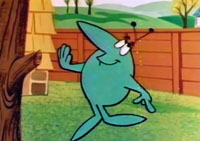 The Kisser Plant (Terrytoons/Fox, Astronut, June 1964, Connie Rasinski, dir) – So quick on the heels of the Porttsylvania Creeper, this short seems to lift nearly the exact same plot and condense it to six minutes. Astro’s human friend Oscar Mild can’t get a garden to grow, and wishes for once he could get something to come up. Astronut, reading his mind waves from space, delivers him a Kisser Plant from his own galaxy, though he doesn’t know how it will react in Earth soil. As soon as planted and watered, the plant, which is not a “man-eater” in appetite, turns out to be a “man-eater” when it comes to romantic interest – grabbing Oscar in its pink leaves and smothering him with kisses from its effeminate bloom. Oscar can’t get out of its grip, as the plant shoots into the air like a beanstalk for Jack. Astro only frees Oscar by pulling him away from the plant with his space ship. Similar to the Pottsylvanis Creeper, the plant runs wild. Instead of an axe, Astro and Oscar try to attack its stem with a lumberjack saw – but are carried ten stories into the air before they can make much more than a dent, and have to abandon their effort. A local cop attempts to intervene. But the plant turns its affections both to the policeman, and his car, causing the cop to crash into a tree. While the officer is still in the plant’s grip, he radios for backup. “Call out the army…the navy…the peace corps…and the advice to the lovelorn editor!” But the efforts are useless. 500 gallons of DDT are swallowed up by the plant as if drinking soda pop from a straw. An army cannon is greeted by the plant sticking its face right into the barrel, and popping out the other end unscathed after the blast to kiss the soldier. The plant’s growth covers the Eastern half of the state, snarling airports and all other transportation. Astronut knows he started this mess and has to stop it, but Oscar has no idea how, assuming by now the plant is well rooted. A brainstorm hits Astro, who jumps in his saucer to retrieve a solution. A short while later, her returns with a large yellow buck-toothed roly-poly of an animal, known as a “Venutian root-grubber”. One sniff of the plant’s roots, and the grubber is off – underground. With lightning speed, he devours the entire roots of the kisser plant. The plant withers, turns brown, and falls dead. Oscar shakes Astro’s hand, congratulating him that the grubber really did the trick. However, Astro is a bit less satisfied with the success, saying “There’s only one trouble with him…..” Suddenly, Oscar’s whole house undergoes tremendous shaking, then collapses into a huge crater in the ground. Astro concludes his sentence: “He just doesn’t know when to stop!”
The Kisser Plant (Terrytoons/Fox, Astronut, June 1964, Connie Rasinski, dir) – So quick on the heels of the Porttsylvania Creeper, this short seems to lift nearly the exact same plot and condense it to six minutes. Astro’s human friend Oscar Mild can’t get a garden to grow, and wishes for once he could get something to come up. Astronut, reading his mind waves from space, delivers him a Kisser Plant from his own galaxy, though he doesn’t know how it will react in Earth soil. As soon as planted and watered, the plant, which is not a “man-eater” in appetite, turns out to be a “man-eater” when it comes to romantic interest – grabbing Oscar in its pink leaves and smothering him with kisses from its effeminate bloom. Oscar can’t get out of its grip, as the plant shoots into the air like a beanstalk for Jack. Astro only frees Oscar by pulling him away from the plant with his space ship. Similar to the Pottsylvanis Creeper, the plant runs wild. Instead of an axe, Astro and Oscar try to attack its stem with a lumberjack saw – but are carried ten stories into the air before they can make much more than a dent, and have to abandon their effort. A local cop attempts to intervene. But the plant turns its affections both to the policeman, and his car, causing the cop to crash into a tree. While the officer is still in the plant’s grip, he radios for backup. “Call out the army…the navy…the peace corps…and the advice to the lovelorn editor!” But the efforts are useless. 500 gallons of DDT are swallowed up by the plant as if drinking soda pop from a straw. An army cannon is greeted by the plant sticking its face right into the barrel, and popping out the other end unscathed after the blast to kiss the soldier. The plant’s growth covers the Eastern half of the state, snarling airports and all other transportation. Astronut knows he started this mess and has to stop it, but Oscar has no idea how, assuming by now the plant is well rooted. A brainstorm hits Astro, who jumps in his saucer to retrieve a solution. A short while later, her returns with a large yellow buck-toothed roly-poly of an animal, known as a “Venutian root-grubber”. One sniff of the plant’s roots, and the grubber is off – underground. With lightning speed, he devours the entire roots of the kisser plant. The plant withers, turns brown, and falls dead. Oscar shakes Astro’s hand, congratulating him that the grubber really did the trick. However, Astro is a bit less satisfied with the success, saying “There’s only one trouble with him…..” Suddenly, Oscar’s whole house undergoes tremendous shaking, then collapses into a huge crater in the ground. Astro concludes his sentence: “He just doesn’t know when to stop!”
Pink Posies (DePatie-Freleng/UA, Pink Panther, 4/26/67 – Hawley Pratt, dir,), is a sort of chapter three to what could be called Pink’s “color battles” with the nameless little man (the first two installments being the original The Pink Phink (1964), where they were warring painters battling between painting the world pink or blue, and the second being The Pink Blueprint (1965), where the battle was moved to a construction site with a home to be built either from the little man’s traditional blueprint of the panther’s ultra-modern pink-print). This time, the little man changes color allegiances – from blue to yellow. As a greenhouse gardener, the man plants from his nursery an outdoor flower bed of yellow posies. Pink, spying on the activity from nearby, cringes at the sight of the yellow blooms, and pulls out his own basket of appropriately pink twins to the yellow flowers. For every flower the man plants, Pink yanks it out and replaces it with a pink one, so by the end of the row, the man looks back to find they’ve all changed color – then even the last flower in front of him does the same while he is turned around. The man goes to his medicine cabinet, examining his eyes and tongue to make sure he’s not fallen ill. The man plucks out all the pink flowers, planting a new row of yellow ones. On the other side of a wall, Pink finds one more yellow posie growing in the dirt. He tugs at it, and finds the roots of all the yellow posies are connected. With a terrific tug, he yanks each successive yellow posie down into the ground. Thinking he has gophers, the little man grabs a shotgun and shoots into one of the holes. On the opposite side of the wall, the panther leaps into the air from the shot, giving the man only a bref glimpse of him. A pink gopher? thinks the man. He returns to his greenhouse and tests his vision with an eye chart.
 The panther decides to speed up the process – with a box of quick-grow pink posie seeds, and a shotgun. He loads seeds into the gun, then shoots. An instant bouquet springs from the ground. He fires again and again, producing more blooms. The man emeges to investigate the gunfire, and gets blasted in the face with a gunbarrel of seeds, which sprout from his head as he passes out.
The panther decides to speed up the process – with a box of quick-grow pink posie seeds, and a shotgun. He loads seeds into the gun, then shoots. An instant bouquet springs from the ground. He fires again and again, producing more blooms. The man emeges to investigate the gunfire, and gets blasted in the face with a gunbarrel of seeds, which sprout from his head as he passes out.
Well, if you can’t use actual seeds – paint is the next best thing. As the next row of yellow posies is planted, Pink spray paints them all pink. The man is hopping mad, and plucks them all out again, planting a new yellow row. This time he lays in wait with a shotgun poked through the window of his shed. But Pink is already inside the shed, and exits with a roll of something under his arm. The impact of the door closing brings the window down on the little man. By the time he comes to, Pink has “unrolled” over his flower bed a new layer of topsoil with pink blooms already imbedded in it! The frustrated man stomps on the flowers in a frenzy. His next planting effort is a direct redo of a scene from “The Pink Phink”, with the man planting a circle of yellow flowers around a large tree trunk, while Pink replaces them with pink flowers on the opposite side of the trunk. Round and round they go in continuous circles changing the colors of each other’s flowers. They race in spiral blurs – but Pink steps out of the blur with grace, and walks away. When the man stops, only pink flowers encircle the tree, five layers deep. And the original straight flower bed has been replanted too. In complete desperation and seeking vengence, the little man hops astride a power lawn mower, determined to mow down the entire crop. Unbeknowst to him, Pink is riding in the back of the mower bag – and as quickly as a flower gets mowed down, Pink takes it out of the bag and replants it again behind them. No matter which way the man rides, all the flowers he cut mysteriously return. Finally, he spots the pather passenger, who smiles a sick sheepish grin. The man grabs his shotgun antd takes aim – but all that comes out of the barrel is another pink bouquet. Throwing aside the gun, the man chases Pink with the mower, and off of his property. The final scene shows the garden gate boarded over, a vicious bulldog in a new home inside the gate, and the happy man with a newly planed row of yellow posies, as he returns to his greenhouse. A second before the iris out, the arm of the panther reaches through the gate bars, grabbing the dirt at one end of the flower bed. He gives the dirt a flip as if the whole bed were on a pivot, and the entire flower bed flips over, burying the yellow posies and exposing a fresh row of pink ones planted on the other side!
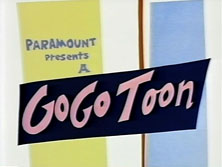 A Bridge Grows In Brooklyn (Paramount. Go Go Toon, 10/1/67 – Chuck Harriton, dir.) – The title is a play on words on the Betty Smith novel, “A Tree Grows in Brooklyn” from 1943. A “breaking ground” ceremony takes place for commencing construction of a suspension bridge. In the course of helping an inept mayor to unearth a shovel full of dirt, a small green plant is revealed in the dirt mound, and unceremoniously dumped in a trash can. A little construction worker referred to as “Fall Guy”, late for his first day on the job, passes the trash can, and is whistled to by the budding plant, which gives him a kiss with its petals. Fall Guy puts the plant in a pot, and takes it with him to the jobsite. His hard-hat foreman has considerable patience for the new trainee, except on one count. “What’s dis?”, he inquires on seeing the plant. Tossing it carelessly away atop a girder, the Hard Hat declares that a bridge worker has no room in his life for flowers – his mind must remain on “the bridge. The bridge. “THE BRIDGE!”, as the foreman’s eyes spin in hypnotic circles. He runs Fall Guy though a series of on-the-job training courses, but Fall Guy continues to find ways to carry along the plant with him, sometimes tripping up his boss, who keeps insisting that he “Get rid of it.” Finally, while Fall Guy is tossing hot rivets, the plant affectionately wraps its vines around Fall Guy’s arm, causing him to miss his aim, and the rivet to drop down his boss’s shirt front. “You rotten plant! I’ll get ya for that!” Hard Hat chases Fall Guy carrying the flower clear across the bridge span, finally grabbing the flower, pulling it from its pot, stomping it into the bridge’s woodworks, and layering a coat of cement over it. Fall Guy weeps at the loss.
A Bridge Grows In Brooklyn (Paramount. Go Go Toon, 10/1/67 – Chuck Harriton, dir.) – The title is a play on words on the Betty Smith novel, “A Tree Grows in Brooklyn” from 1943. A “breaking ground” ceremony takes place for commencing construction of a suspension bridge. In the course of helping an inept mayor to unearth a shovel full of dirt, a small green plant is revealed in the dirt mound, and unceremoniously dumped in a trash can. A little construction worker referred to as “Fall Guy”, late for his first day on the job, passes the trash can, and is whistled to by the budding plant, which gives him a kiss with its petals. Fall Guy puts the plant in a pot, and takes it with him to the jobsite. His hard-hat foreman has considerable patience for the new trainee, except on one count. “What’s dis?”, he inquires on seeing the plant. Tossing it carelessly away atop a girder, the Hard Hat declares that a bridge worker has no room in his life for flowers – his mind must remain on “the bridge. The bridge. “THE BRIDGE!”, as the foreman’s eyes spin in hypnotic circles. He runs Fall Guy though a series of on-the-job training courses, but Fall Guy continues to find ways to carry along the plant with him, sometimes tripping up his boss, who keeps insisting that he “Get rid of it.” Finally, while Fall Guy is tossing hot rivets, the plant affectionately wraps its vines around Fall Guy’s arm, causing him to miss his aim, and the rivet to drop down his boss’s shirt front. “You rotten plant! I’ll get ya for that!” Hard Hat chases Fall Guy carrying the flower clear across the bridge span, finally grabbing the flower, pulling it from its pot, stomping it into the bridge’s woodworks, and layering a coat of cement over it. Fall Guy weeps at the loss.
Hard Hat resumes his original patient demeanor and gives Fall Guy one more chance – at the cable-weaving machine. Lunch whistle sounds, and Fall Guy stupidly leaves the weaving mechanism running and unattended. A cable overstrtches and snaps. Another strand unloops through a pulley, removing support for a girder which falls. One thing leads to another – and everything but the base pylons and wooden planking unravels and collapses. “You unmitigated jerk!” foreman Hard Hat cries. But a miracle occurs. Out of the wooden planking pops a new spurt of growth from Fall Guy’s plant. It extends in ever growing creeping vines, which intertwine in cross-support around each other, sprouting flowers every few inches. Hard Hat tries to cut them down, but is lifted out of the way by tendrils catching him by the belt. Within less than a minute, the entre suspension bridge has been restrung and completed – all with suspension provided by the plant’s vines. Fall Guy mans the toll booth and lets the first cars across, while Hard Hat skips gracefully along the span, irrigating the vines with a watering can. “As I told ya, Fall Guy, bridgework gets ta grow on ya!”
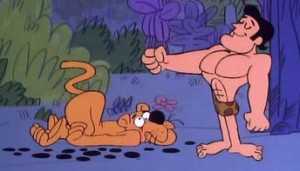 The Trouble I’ve Seed (Jay Ward, George of the Jungle, 11/11/67) – Mad Dr. Chicago (get the pun, movie buffs?) seeds Umbweebwee Province with fast-growing seeds that have one trait in common – they are all kleptomaniacs. Chicago zooms around the province with a scooter and a u-haul trailer scooping up the loot, while his plants invade every building in the province. He even has one of his floral minions steal George’s mate Ursula, and George’s true love of his life – a rhinestone yo-yo. Emptying a loot sack at his hideout, Chicago claims soon he’ll have everything in the province but the kitchen sink. One such fixture falls out of the sack. “I spoke too soon”, comments Chicago. George and the commissioner question where the flowers can be unloading their loot. “At a holly hock shop?”, suggests George. George eventually finds the hideout by swinging through the trees – into an open patch of air where the vines have run out – and crashing through the roof. Chicago says George must face his bodyguard – a man-eating plant called Strangler McVine. A clammy tendril wraps around George’s “goggle”, cutting off his air. Ursula still urges George to call for help. A strangled cry emits from George – and a tremendous swarm of seven-year locusts invades the province. “That funny/ George call for aardvaarks!” The locusts make short work of Chicago’s plants – all except Strangler McVine. At Ursula’s suggestion, George searches for a weak spot, and discovers that Strangler reacts in a fit of giggles to a tickle from George’s toe. Chicago chastizes the plant: “Stop that idiot laughing and get back to man-eating!” The plant does just that – but swallows Chicago instead. All is well – except the unpty-thousand dollar bill the commissioner slaps George with for the damages the locusts caused to every bit of normal vegetation – plus a pair of pants devoured off a leading citizen – the commissioner himself.
The Trouble I’ve Seed (Jay Ward, George of the Jungle, 11/11/67) – Mad Dr. Chicago (get the pun, movie buffs?) seeds Umbweebwee Province with fast-growing seeds that have one trait in common – they are all kleptomaniacs. Chicago zooms around the province with a scooter and a u-haul trailer scooping up the loot, while his plants invade every building in the province. He even has one of his floral minions steal George’s mate Ursula, and George’s true love of his life – a rhinestone yo-yo. Emptying a loot sack at his hideout, Chicago claims soon he’ll have everything in the province but the kitchen sink. One such fixture falls out of the sack. “I spoke too soon”, comments Chicago. George and the commissioner question where the flowers can be unloading their loot. “At a holly hock shop?”, suggests George. George eventually finds the hideout by swinging through the trees – into an open patch of air where the vines have run out – and crashing through the roof. Chicago says George must face his bodyguard – a man-eating plant called Strangler McVine. A clammy tendril wraps around George’s “goggle”, cutting off his air. Ursula still urges George to call for help. A strangled cry emits from George – and a tremendous swarm of seven-year locusts invades the province. “That funny/ George call for aardvaarks!” The locusts make short work of Chicago’s plants – all except Strangler McVine. At Ursula’s suggestion, George searches for a weak spot, and discovers that Strangler reacts in a fit of giggles to a tickle from George’s toe. Chicago chastizes the plant: “Stop that idiot laughing and get back to man-eating!” The plant does just that – but swallows Chicago instead. All is well – except the unpty-thousand dollar bill the commissioner slaps George with for the damages the locusts caused to every bit of normal vegetation – plus a pair of pants devoured off a leading citizen – the commissioner himself.
Next time, we encounter animation’s dealings with one of the last new forces in floral expression – the flower child! – as well as a small bouquet of modern animated treats.


 Charles Gardner is an animation enthusiast who toils by day as a member of LA Law – but by nights and weekends indulges in classic jazz and ragtime as a performer; and studies classic Hollywood cartoons… maybe a little too much.
Charles Gardner is an animation enthusiast who toils by day as a member of LA Law – but by nights and weekends indulges in classic jazz and ragtime as a performer; and studies classic Hollywood cartoons… maybe a little too much.


































































































































































So you’re saying that THE ROAD TO BALI was the last of the Crosby & Hope “Road” movies? I guess you don’t count THE ROAD TO HONG KONG (1962). Neither do I.
The modern stone-age family encounters a man eating plant in “The Gruesomes” (Hanna-Barbera, The Flintstones, Season 5, Episode 9, 12/11/64). While Fred and Barney are giving Bamm-Bamm some batting practice, the world’s strongest baby hits a high fly ball all the way to the far side of Fred’s yard, where his new neighbour Weirdly Gruesome (Howard Morris, channeling Peter Lorre) is throwing steaks to his prize-winning man-eating plant. “They like lots of meat,” Weirdly tells him. Bamm-Bamm’s next hit sends Fred right over the fence, and he is immediately sucked into the carnivorous flower’s voracious maw. “I cannot understand it,” says Weirdly. “She already had a big dinner.” “Maybe she’s having Fred for dessert,” suggests Barney. At Weirdly’s command, the plant spits out Fred and the ball. “She wasn’t hungry,” he explains. “She just wanted to play.”
The Gruesomes, of course, were inspired by the sitcom “The Addams Family”, in which Morticia had a carnivorous plant of her own, the homicidal strangler vine Cleopatra.
Don’t know if 1970 is too late for the timeline being discussed, but in “Haunted House Hangup”, Shaggy and Scooby feed a flytrap that then grows big enough to try to eat them. (There’s also the much later “Hothouse Scooby”).
There was also an old Sesame Street animation showing a plant eating one thing (probably a number or number of items) and then spitting out the next number. (It may have been that soulful version of the 1-12 count).
While not a man eater, how about that mutant potato in Huckleberry Hound? That was one of the more surreal episodes. It struck me odd at four years old. At that time, it was over my head that the episode was a parody of monster movies.
Nothing about the circa 1990 Fox Kid’s version for Little Shop of Horrors? It was a half baked age regressed to grade school age version of the ’80s movie.
“Little Shop” is too late for this week’s chronology. It’ll be featured next week.
Thinking about George of the Jungle, I can think of a bumper where he’s so punch drunk from slamming into all those trees, that he loses a fight with a giant flower, possibly a man eater. At least the stigmas were pounding on his head like a timpani.
That was the last shot of the end credits of the show.
Just a few words about Clarence Wheeler’s score to “Arts and Flowers”. It’s derived entirely from the piano music of Frederic Chopin: the Military Polonaise, Minute Waltz, Fantasie-Impromptu, Waltz in C-sharp minor, etc. Chopin’s music is heard in other cartoons (Bugs Bunny plays the Minute Waltz in “Hyde and Hare”, released the previous year), but never to so great an extent, or so cleverly adapted for comic effect. It’s perfect for sending up the artsy-fartsy painting contest.
You’ve got to hand it to Wheeler: he never scored a cartoon until he was in his sixties, and then he went on to compose 140 of them! Lantz was lucky to have him.
A clammy tendril squeezed Geoge’s GOZZLE or GOOZLE (a.k.a the throat,) not his “GOGGLE.”